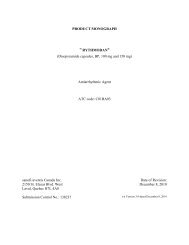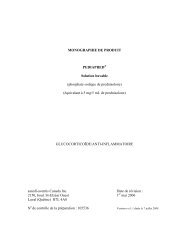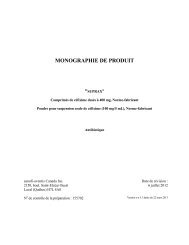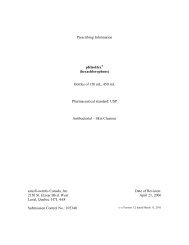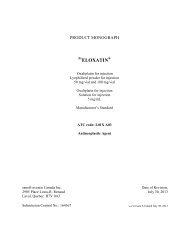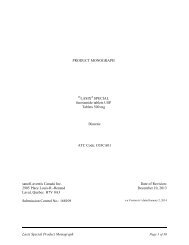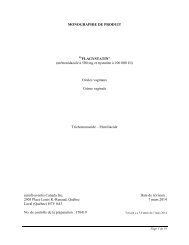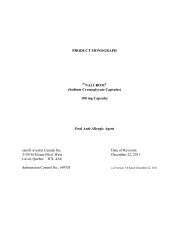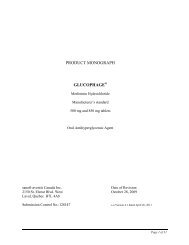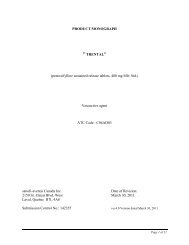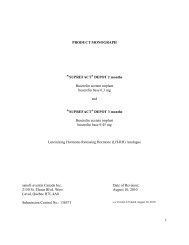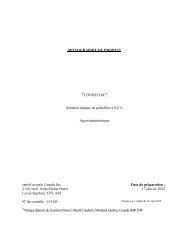Zaroxolyn (metolazone) - Sanofi Canada
Zaroxolyn (metolazone) - Sanofi Canada
Zaroxolyn (metolazone) - Sanofi Canada
Create successful ePaper yourself
Turn your PDF publications into a flip-book with our unique Google optimized e-Paper software.
PRODUCT MONOGRAPHZAROXOLYN®(Metolazone)2.5 mg TabletsDiuretic/Antihypertensivesanofi-aventis <strong>Canada</strong> Inc.Date of Revision:2150 St. Elzear Blvd. West December 15, 2006Laval, Quebec H7L 4A8Submission Control No.: 110489 s-a Version 1.1 dated July 15, 20081
NAME OF DRUGZAROXOLYN®(Metolazone Tablets, USP)2.5 mg tabletsTHERAPEUTIC CLASSIFICATIONDiuretic/AntihypertensiveACTIONS AND CLINICAL PHARMACOLOGYZAROXOLYN (<strong>metolazone</strong>) is a diuretic antihypertensive drug for the treatment of edema.ZAROXOLYN is a quinazoline diuretic, with properties generally similar to the thiazidediuretics. The actions of ZAROXOLYN result from interference with the renal tubularmechanism of electrolyte reabsorption. ZAROXOLYN acts primarily to inhibit sodiumreabsorption at the cortical diluting site and to a lesser extent in the proximal convoluted tubule.Sodium and chloride ions are excreted in approximately equivalent amounts. The increaseddelivery of sodium to the distal-tubular exchange site results in increased potassium excretion.ZAROXOLYN does not inhibit carbonic anhydrase. A proximal action has been shown inhumans by increased excretion of phosphate and magnesium ions, and by a markedly increasedfractional excretion of sodium in patients with severely compromised glomerular filtration.The antihypertensive mechanism of action of <strong>metolazone</strong> is not fully understood but is presumedto be related to its saluretic and diuretic properties.Pharmacokinetics: Metolazone is absorbed rapidly; however, rate and extent of absorption isdependent on the formulation. The table below shows that bioavailability of ZAROXOLYN isdifferent from MYKROX (another product containing <strong>metolazone</strong>):2
Pharmacokinetic Variables of Metolazone*0-48hr AUCFormulationng.hr/mLMetolazone soln 2.5 mg 230.59(61.96)Mykrox 2.5 mg 199.40(36.38)<strong>Zaroxolyn</strong> 2.5 mg 99.74(28.97)* Values presented are means ("SD)0-4 AUCng.hr/mL235.4(61.50)209.4(41.00)127.0(37.08)CMAXng/mL37.50(9.91)18.75(2.58)3.63(0.87)TMAXhr1.25(0.44)3.17(1.03)7.67(6.65)Clinical studies have shown that ninety to nine-five percent of <strong>metolazone</strong> is bound to red bloodcells and plasma protein. The prolonged duration of action of <strong>metolazone</strong> is attributed to itsprotein binding and allows for once a day dosing. Only a small amount of <strong>metolazone</strong> ismetabolized. Most of the drug is excreted in the unconverted form in the urine.When ZAROXOLYN (<strong>metolazone</strong>) is given, diuresis and saluresis usually begin within one hourand persist for 24 hours depending on the dose. The effect may be prolonged beyond 24 hoursparticularly at the higher recommended dosages.INDICATIONS AND CLINICAL USEZAROXOLYN (<strong>metolazone</strong>) is indicated for the treatment of edema accompanying congestiveheart failure and edema accompanying renal diseases including the nephrotic syndrome, andstates of diminished renal function. ZAROXOLYN (2.5 mg) has also been used in themanagement of mild to moderate essential hypertension, alone or in combination with otherantihypertensive drugs of a different class.CONTRAINDICATIONSZAROXOLYN (<strong>metolazone</strong>) is contraindicated in anuria, in hepatic coma or pre-coma, and incases of known allergy and hypersensitivity to <strong>metolazone</strong>.WARNINGSRarely, the rapid onset of severe hyponatremia and/or hypokalemia has been reported followinginitial doses of thiazide and non-thiazide diuretics. When symptoms consistent with severeelectrolyte imbalance appear rapidly, the drug should be discontinued and supportive measuresshould be initiated immediately. The appropriateness of therapy with this class of drug should becarefully re-evaluated.3
Hypokalemia may occur, with consequent weakness, cramps, and cardiac arrhythmias.Hypokalemia is a particular hazard in digitalized patients or those who have had or have aventricular arrhythmia; dangerous or fatal arrhythmias may be precipitated. Serum potassiumshould be determined at regular intervals, and dose reduction, potassium supplementation oraddition of a potassium sparing diuretic instituted if indicated. Hypokalemia is dose related. (SeePRECAUTIONS).Azotemia and hyperuricemia may be noted or precipitated during the administration ofZAROXOLYN (<strong>metolazone</strong>). Infrequently, gouty attacks have been reported in persons with ahistory of gout. If azotemia and oliguria worsen during treatment of patients with severe renaldisease, <strong>metolazone</strong> should be discontinued.Unusually large or prolonged losses of fluid and electrolytes may result when <strong>metolazone</strong> isadministered concomitantly to patients receiving furosemide.Particular care must be taken, especially during initial therapy, when <strong>metolazone</strong> is used withother antihypertensive drugs of a different class to avoid excessive reduction in blood pressure.(See PRECAUTIONS, Drug Interactions).PRECAUTIONSAll patients receiving <strong>metolazone</strong> should have serum electrolytes measured at appropriateintervals and be observed for clinical signs of fluid and/or electrolyte imbalance; namely,hyponatremia, hypochloremic alkalosis, and hypokalemia. Serum and urine electrolytedeterminations are particularly important when the patient is vomiting excessively, has severediarrhea, or is receiving parenteral fluids.The risk of hypokalemia is increased when larger doses are used; when diuresis is rapid; whensevere liver disease is present; when corticosteroids are given concomitantly; when oral intake ofpotassium is inadequate or when excess potassium is being lost extrarenally; such as withvomiting or diarrhea.Hyponatremia may occur at any time during long term therapy and, on rare occasions, may belife threatening (See WARNINGS).Warning signs of electrolyte imbalance irrespective of cause are: dryness of mouth; thirst;weakness; lethargy; drowsiness; restlessness; muscle pains or cramps; muscular fatigue;hypotension; oliguria; tachycardia; and gastrointestinal disturbances such as nausea andvomiting.4
Use of diuretics similar to <strong>metolazone</strong> have been associated, on rare occasions, with pathologicchanges in the parathyroid glands. This possibility should be kept in mind with clinical use of<strong>metolazone</strong>. Hypercalcemia has been noted in a few patients.Sulfonamide derivatives have been reported to exacerbate or activate systemic lupuserythematosus.Orthostatic hypotension may occur; this may be potentiated by alcohol, barbiturates, narcotics,or concurrent therapy with other antihypertensive drugs.Special caution should be used in treating patients with severe hepatic disease since <strong>metolazone</strong>may induce metabolic alkalosis in cases of potassium depletion which may precipitate episodesof hepatic encephalopathy. (See CONTRAINDICATIONS).Caution should be observed when administering <strong>metolazone</strong> to patients with severely impairedrenal function. As most of the drug is excreted by the renal route, cumulative effects may be seen.(See CONTRAINDICATIONS).Metolazone may raise blood glucose concentrations, possibly causing hyperglycemia andglycosuria in patients with diabetes or latent diabetes.Laboratory Tests: Periodic determination of serum electrolytes; blood urea nitrogen; uric acid,and glucose levels should be assessed at appropriate intervals during <strong>metolazone</strong> therapy. (SeeWARNINGS).Drug Interactions:Alcohol, barbiturates, or narcotics: See PRECAUTIONS.Antihypertensives: See WARNINGS and PRECAUTIONS. When <strong>metolazone</strong> is used with otherantihypertensive drugs, particular care must be taken, especially during initial therapy. Dosage ofother antihypertensive agents, especially the ganglionic blockers and quanethidine, should bereduced. Hydralazine in therapeutic doses may interfere with the natruretic action of <strong>metolazone</strong>.Corticosteroids or ACTH Therapy: May increase the risk of hypokalemia and increase salt andwater retention.Curariform Drugs: Diuretic-induced hypokalemia may enhance neuromuscular blocking effectsof curariform drugs (such as tubocurarine). The most serious effect would be respiratorydepression which could proceed to apnea. Accordingly, it is advisable to discontinue <strong>metolazone</strong>tablets three days before elective surgery.Digitalis: See WARNINGS.5
Drugs Used to Treat Gout: See WARNINGS. Dosage adjustment of the gout medication may benecessary to control hyperuricemia and gout.Furosemide and Other Loop Diuretics: See WARNINGS. Unusually large or prolonged losses offluids and electrolytes may result.Insulin and Oral Antidiabetic Agents: Adjustment of dosage may be necessary. SeePRECAUTIONS.Lithium: See WARNINGS.Methenamine: Efficacy may be decreased due to urinary alkalizing effect of <strong>metolazone</strong>.Salicylates and Other Nonsteroidal Anti-inflammatory Agents: May antagonize natruretic,diuretic and antihypertensive effects of <strong>metolazone</strong>. Patients should be monitored carefully.Sympathomimetics: May decrease the antihypertensive effect of <strong>metolazone</strong>. Metolazone maydecrease arterial responsiveness to norepinephrine, but this diminution is not sufficient topreclude effectiveness of the pressor agent for therapeutic use.Use in Pregnancy: Since <strong>metolazone</strong> crosses the placenta and appears in cord blood, itsadministration to women of childbearing age requires that the potential benefits of the drug beweighed against its possible hazards to the fetus. The potential effects on the fetus include fetalor neonatal jaundice, thrombocytopenia, and possibly other adverse reactions which haveoccurred in the adult. However, teratogenic studies in mice, rats and rabbits, have not shownteratologic effects in these animals.Nursing Mothers: Metolazone appears in breast milk. Thus, it is possible that the effects of<strong>metolazone</strong> may occur in the newborn under these circumstances. If the use of <strong>metolazone</strong> isdeemed essential for a nursing mother, the patient should stop nursing.Use in Children: Safety and effectiveness in children have not been established; therefore,<strong>metolazone</strong> is not recommended for use in the pediatric age group.ADVERSE REACTIONSThe following adverse reactions have been reported. Several are single or comparably rareoccurrences. Adverse reactions are listed in decreasing order of severity within body systems.Cardiovascular: Chest pain/discomfort, orthostatic hypotension, excessive volume depletion,hemoconcentration, venous thrombosis, palpitations.6
Central and Peripheral Nervous System: Syncope, neuropathy, vertigo, paresthesias, psychoticdepression, impotence, dizziness/lightheadedness, drowsiness, fatigue, weakness, restlessness,sometimes resulting in insomnia), headache.Dermatologic/Hypersensitivity: Necrotizing angitis (cutaneous vasculitis), purpura, dermatitis(photosensitivity), urticaria and skin rashes.Gastrointestinal: Hepatitis: intrahepatic cholestatic jaundice, pancreatitis, vomiting, nausea,epigastric distress, diarrhea, constipation, anorexia, abdominal bloating.Hematologic: Aplastic/hypolastic anemia, agranulocytosis, leukopenia.Metabolic: Hypokalemia, hyponatremia, hyperuricemia, hypochloremia, hypochloremicalkalosis, hyperglycemia, glycosuria, increase in serum urea nitrogen (BUN) or creatinine,hypophosphatemia (See WARNINGS and PRECAUTIONS).Musculoskeletal: Joint pain, acute gouty attacks, muscle cramps or spasm.Other: Transient blurred vision, chills.In addition, adverse reactions reported with similar antihypertensive diuretics, but which havenot been reported to date for ZAROXOLYN include: bitter taste, dry mouth, sialadenitis,xanthopsia, respiratory distress (including pneumonitis), thrombocytopenia and anaphylacticreactions. These reactions should be considered as possible occurrences with clinical usage ofZAROXOLYN.Whenever adverse reactions are moderate or severe, ZAROXOLYN dosage should be reduced ortherapy withdrawn.SYMPTOMS AND TREATMENT OF OVERDOSAGESigns and Symptoms: Orthostatic hypotension, dizziness, drowsiness, syncope, diuresis withaccompanying electrolyte abnormalities, hemoconcentration and hemodynamic changes due toplasma volume depletion may occur. In some instances, depressed respiration may be observed.At high doses, lethargy of varying degree may appear and may progress to coma within a fewhours. Also, GI irritation and hypermotility may occur. Temporary elevation of BUN has beenreported, especially in patients with impairment of renal function.7
Treatment: There is no specific antidote available, but immediate evacuation of the stomachcontents is advised. Care should be taken when evacuating the gastric contents to preventaspiration, especially in the stuporous or comatose patient. Dialysis is not likely to be effective.Supportive measures should be initiated as required to maintain hydration, electrolyte balance,respiration and cardiovascular and renal functions.Serum electrolyte change, and cardiovascular and renal functions, should be closely monitored.DOSAGE AND ADMINISTRATIONEffective dosage of ZAROXOLYN (<strong>metolazone</strong>) should be individualized according toindications and patient response. A single daily dose is recommended. Therapy withZAROXOLYN should be titrated to gain an initial therapeutic response and to determine theminimal dose possible to maintain the desired therapeutic response.Usual Dosages:EdemaEdema of cardiac failure:Edema of renal disease:ZAROXOLYN 5-10 mg, once dailyZAROXOLYN 5-20 mg, once dailyTreatment of Edematous States: The time interval for the initial dosage to show effect may vary;diuresis and saluresis usually begin within one hour and persist for 12 to 24 hours, depending ondosage. When a desired therapeutic effect has been obtained, it may be advisable to reduce thedose, if possible. The daily dose depends on the severity of the patient=s condition, sodium intakeand responsiveness. A decision to change the daily dose should be based upon the results ofthorough clinical and laboratory determinations. If antihypertensive drugs or diuretics are givenconcurrently with ZAROXOLYN, more careful dosage adjustment may be necessary. Forpatients with congestive cardiac failure who tend to experience paroxysmal nocturnal dyspnea, itis usually advisable to employ a dosage near the upper end of the range to ensure prolongation ofdiuresis and saluresis for a full 24-hour period.Hypertension:Mild to moderate essential hypertension:ZAROXOLYN 2.5 - 5 mg , once daily.Treatment of Hypertension:The time interval required for the initial dosage regimen of ZAROXOLYN to show effect mayvary from three to four days, to three to six weeks, in the treatment of elevated blood pressure.Doses should be adjusted at appropriate intervals to achieve maximum therapeutic effect.8
PHARMACEUTICAL INFORMATIONCHEMISTRYTrade Name:Proper Name:ZAROXOLYN<strong>metolazone</strong>Chemical name: 7-chloro-1,2,3,4-tetrahydro-2-methyl-3- 2-methylphenyl)-4-oxo-6-quinazolinesulfonamideStructural Formula:Molecular Formula: C 16 H 16 ClN 3 O 3 SMolecular Weight: 365.83Description:Solubility:white crystalline powderin water (gm/mL): 2.4 x 10 -5 , 25ECin 95% ethanol (gm/mL): 9 x 10 -3 ,25ECin serum (gm/mL): 4.2 x 10 -5 , 37ECpKa: 9.7Melting Point:Composition:253 - 259ECZAROXOLYN 2.5 mg tablets contain 2.5 mg of the active ingredient<strong>metolazone</strong>.Stability and Storage Recommendations:ZAROXOLYN (<strong>metolazone</strong>) should be stored at room temperature and protected from light.ZAROXOLYN should be dispensed in tight, light-resistant containers.9
DOSAGE FORMS:ZAROXOLYN (<strong>metolazone</strong>) 2.5 mg is available as a pink, slightly biconvex tablet, debossedwith its numeric strength on one side and "ZAROXOLYN" on the other and contains 2.5 mg<strong>metolazone</strong>. The tablets are available in high density polyethylene bottles of 100 tablets.Non-medicinal ingredients: D&C Red #33 aluminum lake, magnesium stearate andmicrocrystalline cellulose. Alcohol-, gluten-, lactose-, paraben-, sucrose- and tartrazine- free.Animal Pharmacodynamics:PHARMACOLOGYThe dominant pharmacologic actions of <strong>metolazone</strong> in animals are saluresis and diuresis. Theseeffects have been demonstrated in rats and dogs and indicate an interference with the renaltubular mechanism of electrolyte reabsorption. The pattern of water and electrolyte excretionappears to be similar to that of some thiazides. Studies with desoxycorticosterone acetatesaline-induced hypertension in rats have also demonstrated <strong>metolazone</strong> to be an effectiveantihypertensive agent; hypertension was reduced by <strong>metolazone</strong>, as well as inhibited bypretreatment with the drug.Renal Effects:Metolazone interferes with the renal tubular mechanism of electrolyte reabsorption and actsprimarily to inhibit sodium reabsorption at the cortical diluting site of the distal segment and inthe proximal convoluted tubule. Sodium and chloride ions are excreted in approximatelyequivalent amounts. Metolazone may also evoke a significant increase of potassium excretion inan amount sufficient to produce hypokalemia. With inhibition of sodium reabsorption, a higherconcentration of this cation reaches the distal segment of the nephron and provides a morefavorable milieu for the exchange process.Metolazone produces a decrease in free water clearance in man and animals. Followingintravenous administration of <strong>metolazone</strong> in doses up to 1 mg/kg, in hydrated dogs, free waterclearance decreased, solute-free water reabsorption increased markedly, while the clearance ofcreatinine and PAH did not change significantly. Free water clearance is a function of sodiumreabsorption in the cortical segment of the ascending Loop of Henle or early distal convolutedtubule. In most of the clinical studies, free water clearance diminished although urine flowincreased, establishing a distal tubular site of action for <strong>metolazone</strong>.10
In addition to this primary site of action in the cortical diluting segment, micropuncture andsimultaneous clearance studies in dogs indicate a second site of action in the proximal tubule. Inhumans, a proximal site of action is inferred from measurements of excreted magnesium,phosphate and bicarbonate in the urine of hydrated and hydropenic subjects, from markedlyincreased fractional excretion of sodium and from increased excretion of phosphate andmagnesium ions in patients with severely compromised glomerular filtration rate.Metolazone possesses some carbonic anhydrase inhibitory action, and probably has a very slightaction on bicarbonate transport by the kidney. The inhibition occurs in vitro only at highconcentrations and, therefore, would appear to play little, if any, part in the diuretic action of thedrug. The renal effects of the drug are virtually independent of alterations in acid-base balance.Dogs made acidotic or alkalotic by oral administration of ammonium chloride or sodiumbicarbonate respectively, responded to intravenous administration of <strong>metolazone</strong>. Urinarysodium, potassium and chloride excretion are increased.Metolazone does not significantly decrease the glomerular filtration rate in man, although inanimals the effect is variable under different experimental conditions.The drug exerted its natriuretic and diuretic effects on both normal and adrenalectomized rats. Itsaction, therefore, does not depend on aldosterone inhibition.Pharmacokinetics:Studies in several species of animals indicate that <strong>metolazone</strong> is readily absorbed with an onsetof diuretic effect within one (1) hour. Absorption is dose related up to levels of 50 mg/kg orally;the maximum effect is attained within 3-6 hours of oral administration.Within 48 hours of an oral dose, 95% of the administered dose of <strong>metolazone</strong> is eliminated in theurine and feces of rats, dogs and monkeys. An average of 50% is eliminated unchanged.Rat studies have shown <strong>metolazone</strong> to be distributed mainly in the soft tissue with little, if any,in the nerves, brain, bones or eyes. Metolazone passes readily through the placental barrier to thefetus and is found in the milk of lactating animals.Acute Toxicology:TOXICOLOGYA single oral dose of 10 gm/kg was not lethal in rats, and a single intraperitoneal dose of 5gm/kg was not lethal in mice. Acute effects in susceptible animals include electrolyte imbalance.11
Administration of single high doses (100 to 200 mg/kg) of <strong>metolazone</strong> intraperitoneally to ratscaused a hyperglycemic effect, a decrease in liver glycogen, and an increase in plasma-free fattyacids. Adrenalectomy, nephrectomy, or pretreatment with α- and β-adrenergic blocking agentsreduced this hyperglycemia significantly, suggesting than an adrenergic mechanism (possiblystress), as well as a renal mechanism, were involved.Chronic Toxicity:Daily doses up to 50 mg/kg given orally for one year did not produce noticeable toxic effects inrats, dogs, or monkeys. Mild hypokalemia and slight elevation of blood urea nitrogen occurred insome of the dogs. In the majority of these cases, the abnormal value returned to near normalbefore the study ended and while the animals were still under treatment.Carcinogenicity:Long-term animal studies with <strong>metolazone</strong> have not shown any evidence of carcinogenicity.Mice and rats given the drug for 18 months to 2 years at doses of 2, 10 and 50 mg/kg by stomachtube, showed no evidence that <strong>metolazone</strong> caused an increased number of tumors; however, thesmall number of animals examined histologically, and poor survival in the mice, limitconclusions that can be reached from these studies.Mutagenicity:A mutagenicity study using Salmonella typhimurium strains TA1535, TA97, TA98, TA100, andTA102 as indicator organisms and concentrations of 100 to 10,000 mcg/plate of <strong>metolazone</strong>showed no evidence of mutagenic potential.Reproduction & Teratology:Teratologic studies and studies of reproductive performance in mice, rats and rabbits (including athree-generation study with rats) treated with oral doses ranging from 0.2 to 50 mg/kg showed noevidence of teratologic effects. Reproductive studies in mice and rats have shown no evidence ofaltered reproductive capacity in mice; however, in a rat study in which males were treated orallywith <strong>metolazone</strong> at doses of 2, 10 and 50 mg/kg for 127 days prior to mating with untreatedfemales, an increased number of resorption sites were observed in dams mated with males fromthe 50 mg/kg group. In addition, the fetal weight was decreased and the pregnancy rate wasreduced in dams mated with males from the 10 and 50 mg/kg group.12
BIBLIOGRAPHY1. Belair EJ. The renal pharmacology of <strong>metolazone</strong>2-methyl-3-o-tolyl-6-sulfamyl-7-chloro-1,2,3,4-tetrahydro-4-quinazoline. Res CommunChem Pathol Pharmacol 1971; 2:98-177.2. Cangiano JL, Campos JA, Trevino A, et al. The effects of <strong>metolazone</strong> in the long-termtreatment of essential hypertension. Curr Ther Res 1974:16:778-785.3. Fernadez PC, Puschett JB. Proximal tubular actions of <strong>metolazone</strong> and chlorothiazide.Am J Physiol 1973;225:954-961.4. Materson BJ. Diuretic dose-response relationships. Mod Med 1988;56:47-52.5. Miller RP, Woodworth JR, Graves DA, et al. Comparison of three formulations of<strong>metolazone</strong>: Bioavailability and pharmacologic effects. Curr Ther Res1988;43(6):1133-1142.6. Moser M. Low-dose diuretic therapy for hypertension. Clin Ther 1986;8(5):554-562.7. Puschett JB. Clinical pharmacology of <strong>metolazone</strong>. Mod Med 1988;56:53-61.8. Schoenberger JA. Diuretic strategy in the management of hypertension. A 10 year reviewof clinical experience with <strong>metolazone</strong>. Health Sci Rev 1982;1:1-53.9. Shetty BV, Campanella LA, Thomas TL, et al. Synthesis and activity of some 3-aryl-and3-aralkyl-1,2,3,4-tetrahydro-4-oxo-6-quinazolinesulfonamides. J Med Chem1970;13:886-895.10. Webster J. Interaction of NSAIDs with diuretics and β-blockers. Mechanism and clinicalimplications. Drugs 1985;30:32-41.13



